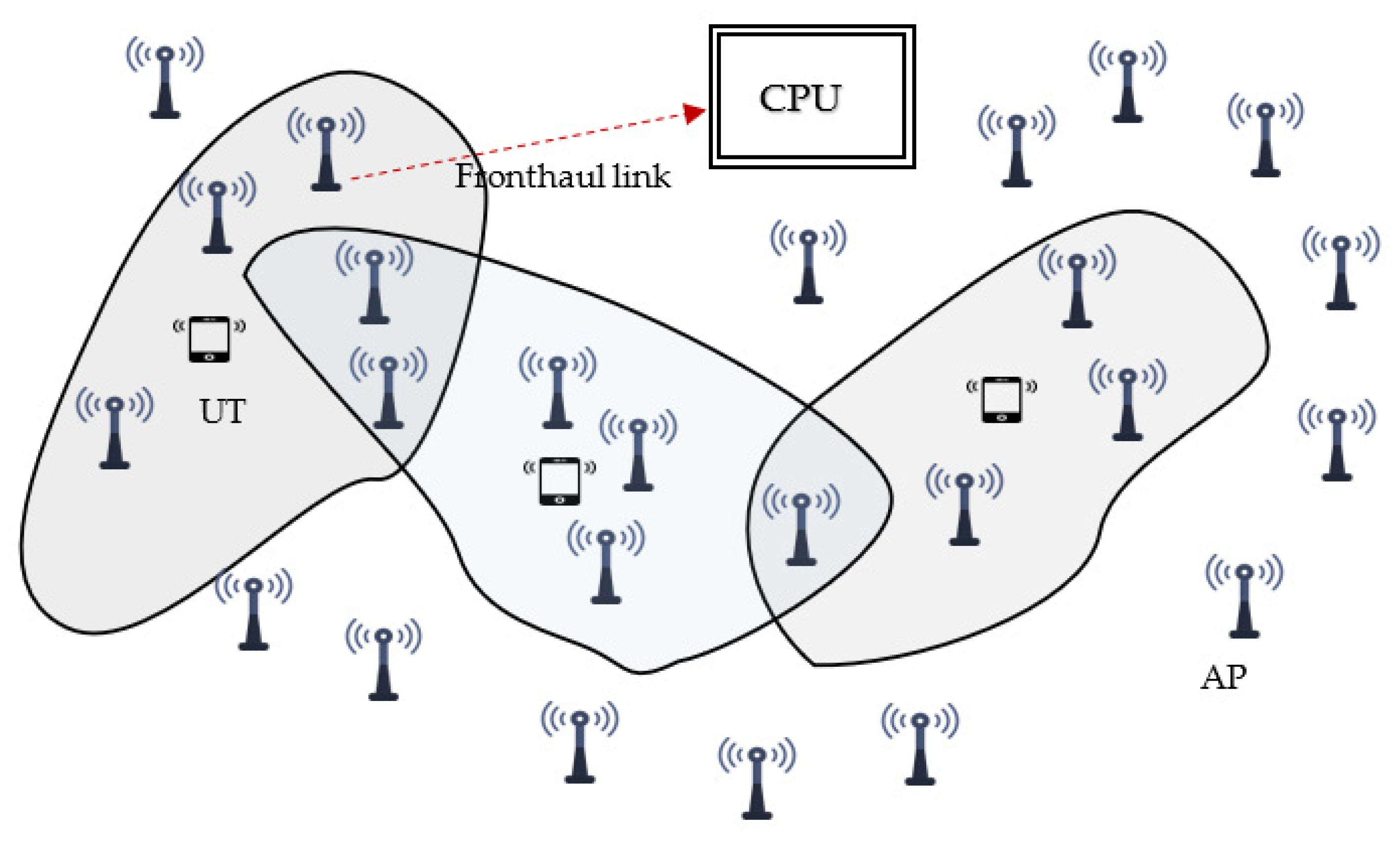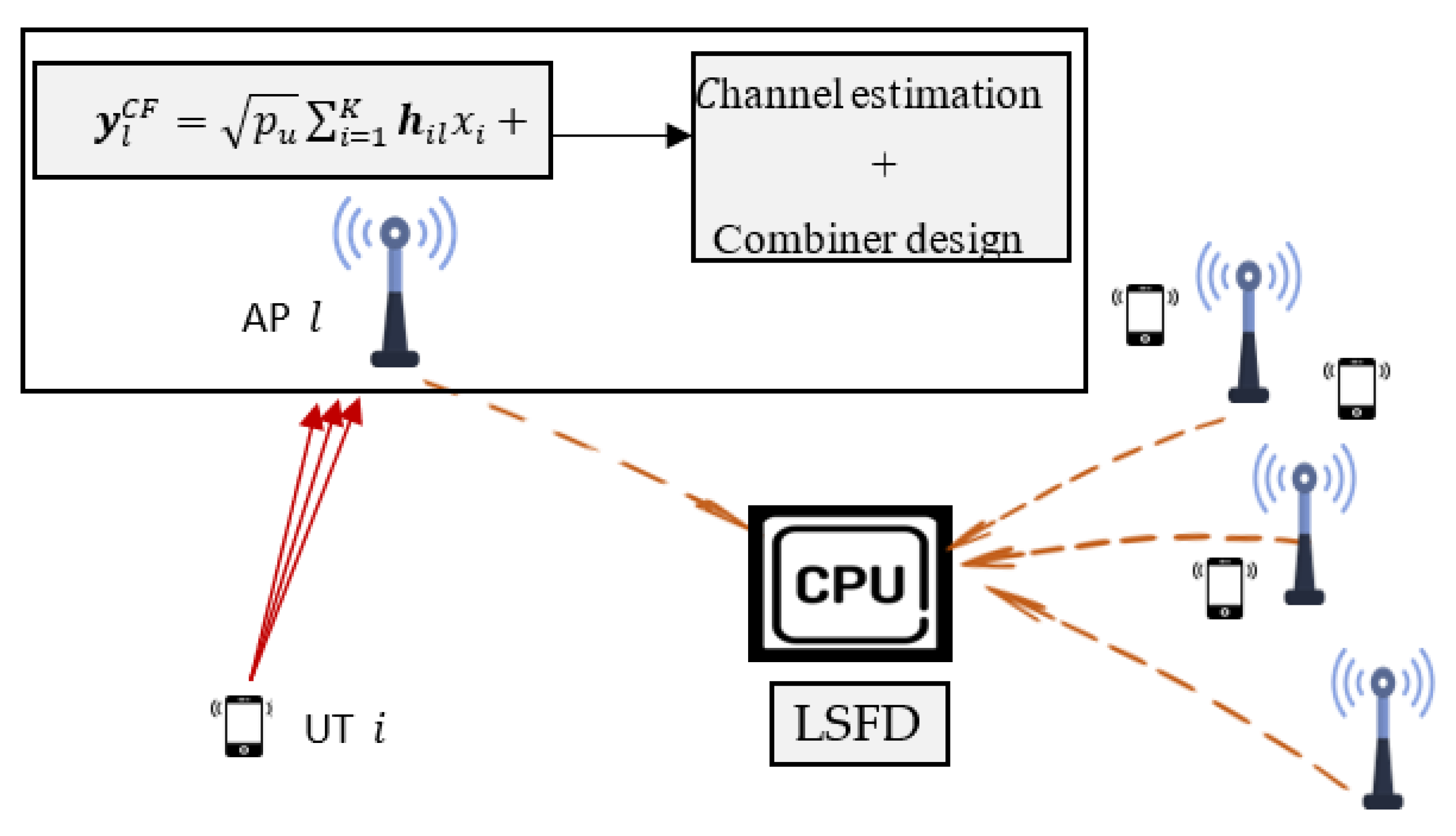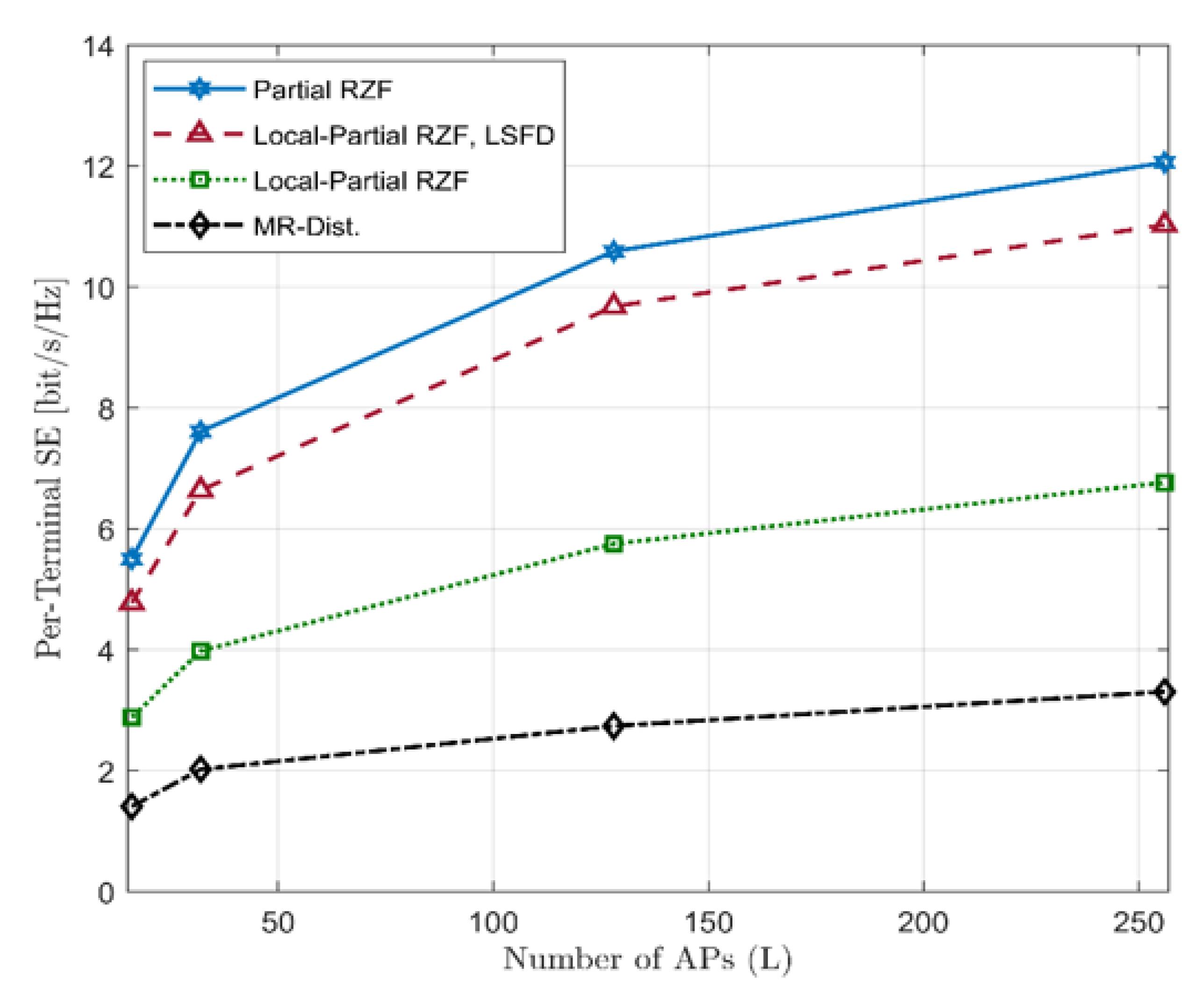Local-Partial Signal Combining Schemes for Cell-Free Large-Scale MU-MIMO Systems with Limited Fronthaul Capacity and Spatial Correlation Channels
Abstract
:1. Introduction
- (1)
- The channel estimation process is performed locally at each access point;
- (2)
- Combiner design and data estimation are performed locally at each access point;
- (3)
- APs use the fronthaul links to send the data estimates only;
- (4)
- An additional stage of data estimation is performed centrally by the CPU.
1.1. Related Work
- All users are served by all APs in the same time-frequency resources: For example, authors in [39] investigated the achievable uplink rate performance of the cell-free systems with perfect/imperfect CSI and Zero Forcing (ZF) processing. However, in practice and as a result of this assumption, the system will not be scalable, implying that the system will be unable to manage an increasing number of active UTs and APs. Furthermore, this configuration is impractical since only a limited number of APs can beneficially communicate with a particular UT. To address these constraints and maintain scalability, we consider a practical system configuration that allows UTs to dynamically choose their subset of APs. Thus, a group of nearby APs are cooperatively serving each UT, as shown in Figure 1. In this user-centric configuration, a clustering technique known as Dynamic Cooperative Clustering (DCC) is used, which allows UTs to choose their preferred set of serving APs. With the DCC approach, the scalability comes from the fact that only the UT’s corresponding subset of APs will be involved in the signal processing. The works in [40,41] have investigated a user-centric configuration for cell-free systems with different channel estimators. However, these studies are based on simple beamforming/combining schemes with some idealized assumptions.
- Unlimited fronthaul/backhaul link capacity: For example, the authors in [42] investigate the downlink of a cell-free system considering power control technique and the ZF process. However, each fronthaul/backhaul connection will have a finite capacity when dealing with practical systems. Moreover, to achieve scalability, it is necessary to restrict the fronthaul signaling between the APs and the CPU. The authors in [43] investigated the impact of using capacity constrained fronthaul links on the average max–min rate per user, considering low-complexity hybrid precoders/decoders. However, the study focuses on the centralized case where the baseband processing of the transmitted signals is fully performed at the CPU. We investigate the uplink of a cell-free large-scale MU-MIMO system with distributed implementation, limited fronthaul links, and the DCC approach.
- The propagation channels are spatially uncorrelated: For example, studies in [44,45] analyzed the system performance under independent Rayleigh channels using general models such as uncorrelated Rayleigh fading. However, in practice, the correlation between the antenna elements is inherent in the implementation of the cell-free system due to the large number of APs. For a realistic performance investigation of cell-free systems, a physical correlated channel model is considered in this paper.
1.2. Contributions
- Uplink System modeling: In this paper, we consider the uplink scenario of a user-centric cell-free system with finite capacity fronthaul links to investigate the impact of distributing the signal processing between the APs and the CPU for achieving a certain level of performance. The distributed system implementation is modeled and numerically simulated. The goal of this research is to provide a further understanding of partial local distributed cell-free systems under more realistic system considerations.
- Analysis of distributed implementations for user-centric cell-free system: Two system configurations, namely, locally distributed and two-stage distributed, are considered to study how competitive these configurations are to a centralized-based system configuration vis-à-vis the achieved SE. Extensive simulations have been performed to evaluate the system’s performance from different perspectives, including the effect of increasing the pilot length, APs number, and APs’ antennas for the three schemes: Partial RZF, Local-Partial RZF, and Distributed MR.
- Distributed Physical layer processing: The essential local physical layer procedures in the distributed user-centric cell-free uplink transmission, such as pilot signaling, channel estimation, and data detection, are identified. Using different bounding techniques, we derive an approximation for the effective SINR using the clustering concept and the large-scale fading decoding (LSFD)scheme.
1.3. Paper Organization
2. System Model
2.1. Uplink Training and Channel Estimation
2.2. Combiner Design and Signal Detection
3. Computational Complexity and Fronthaul Signaling
4. Spatial Correlation Model
5. Numerical Results and Discussion
5.1. Local-Partial Distributed Implementation
5.2. Multiple Antennas APs
5.3. Computational Complexity
5.4. Discussion
6. Conclusions
Author Contributions
Funding
Conflicts of Interest
References
- Björnson, E.; Sanguinetti, L.; Wymeersch, H.; Hoydis, J.; Marzetta, T.L. Massive MIMO is a reality—What is next? Five promising research directions for antenna arrays. Digit. Signal Process. 2019, 94, 3–20. [Google Scholar] [CrossRef]
- Shafi, M.; Molisch, A.F.; Smith, P.J.; Haustein, T.; Zhu, P.; De Silva, P.; Tufvesson, F.; Benjebbour, A.; Wunder, G. 5G: A tutorial overview of standards, trials, challenges, deployment, and practice. IEEE J. Sel. Areas Commun. 2017, 35, 1201–1221. [Google Scholar] [CrossRef]
- Wang, C.; Bian, J.; Sun, J.; Zhang, W.; Zhang, M. A Survey of 5G Channel Measurements and Models. IEEE Commun. Surv. Tutor. 2018, 20, 3142–3168. [Google Scholar] [CrossRef]
- Lin, Z.; Niu, H.; An, K.; Wang, Y.; Zheng, G.; Chatzinotas, S.; Hu, Y. Refracting RIS-Aided Hybrid Satellite-Terrestrial Relay Networks: Joint Beamforming Design and Optimization. IEEE Trans. Aerosp. Electron. Syst. 2022, 58, 3717–3724. [Google Scholar] [CrossRef]
- Da Silva, M.M.; Guerreiro, J. On the 5G and Beyond. Appl. Sci. 2020, 10, 7091. [Google Scholar] [CrossRef]
- Lin, Z.; An, K.; Niu, H.; Hu, Y.; Chatzinotas, S.; Zheng, G.; Wang, J. SLNR-based Secure Energy Efficient Beamforming in Multibeam Satellite Systems. IEEE Trans. Aerosp. Electron. Syst. 2022, 1–4. [Google Scholar] [CrossRef]
- Rappaport, T.S.; Sun, S.; Mayzus, R.; Zhao, H.; Azar, Y.; Wang, K.; Wong, G.N.; Schulz, J.K.; Samimi, M.; Gutierrez, F. Millimeter Wave Mobile Communications for 5G Cellular: It Will Work! IEEE Access 2013, 1, 335–349. [Google Scholar] [CrossRef]
- Han, S.; Chih-Lin, I.; Xu, Z.; Rowell, C. Large-scale antenna systems with hybrid analog and digital beamforming for millimeter wave 5G. IEEE Commun. Mag. 2015, 53, 186–194. [Google Scholar] [CrossRef]
- Lin, Z.; Lin, M.; Wang, J.-B.; de Cola, T.; Wang, J. Joint Beamforming and Power Allocation for Satellite-Terrestrial Integrated Networks With Non-Orthogonal Multiple Access. IEEE J. Sel. Top. Signal Process. 2019, 13, 657–670. [Google Scholar] [CrossRef]
- Dai, L.; Wang, B.; Yuan, Y.; Han, S.; Chih-Lin, I.; Wang, Z. Non-orthogonal multiple access for 5G: Solutions challenges opportunities and future research trends. IEEE Commun. Mag. 2015, 53, 74–81. [Google Scholar] [CrossRef]
- Lin, Z.; Lin, M.; de Cola, T.; Wang, J.-B.; Zhu, W.-P.; Cheng, J. Supporting IoT with Rate-Splitting Multiple Access in Satellite and Aerial-Integrated Networks. IEEE Internet Things J. 2021, 8, 11123–11134. [Google Scholar] [CrossRef]
- Marzetta, T.L. Noncooperative Cellular Wireless with Unlimited Numbers of Base Station Antennas. IEEE Trans. Wirel. Commun. 2010, 9, 3590–3600. [Google Scholar] [CrossRef]
- Rusek, F.; Persson, D.; Lau, B.K.; Larsson, E.G.; Marzetta, T.L.; Tufvesson, F. Scaling up MIMO: Opportunities and Challenges with Very Large Arrays. IEEE Signal Process. Mag. 2013, 30, 40–60. [Google Scholar] [CrossRef]
- Ngo, H.Q.; Larsson, E.G.; Marzetta, T.L. Energy and Spectral Efficiency of Very Large Multiuser MIMO Systems. IEEE Trans. Commun. 2013, 61, 1436–1449. [Google Scholar]
- Larsson, E.G.; Edfors, O.; Tufvesson, F.; Marzetta, T.L. Massive MIMO for next-generation wireless systems. IEEE Commun. Mag. 2014, 52, 186–195. [Google Scholar] [CrossRef]
- Hoydis, J.; ten Brink, S.; Debbah, M. Massive MIMO in the UL/DL of cellular networks: How many antennas do we need? IEEE J. Sel. Areas Commun. 2013, 31, 160–171. [Google Scholar] [CrossRef]
- Björnson, E.; Hoydis, J.; Sanguinetti, L. Massive MIMO Networks: Spectral, Energy, and Hardware Efficiency. Found. Trends Signal Process. 2017, 11, 154–655. [Google Scholar] [CrossRef]
- Alammari, A.A.; Sharique, M. Spatial channel correlation for local scattering with linear MMSE-based estimator and detector in multi-cell large scale MU-MIMO networks. Trans. Emerg. Telecommun. Technol. 2021, 32, e4366. [Google Scholar] [CrossRef]
- Irmer, R.; Droste, H.; Marsch, P.; Grieger, M.; Fettweis, G.; Brueck, S.; Mayer, H.-P.; Thiele, L.; Jungnickel, V. Coordinated multipoint: Concepts performance and field trial results. IEEE Commun. Mag. 2011, 49, 102–111. [Google Scholar] [CrossRef]
- Wang, D.; Wang, J.; You, X.; Wang, Y.; Chen, M.; Hou, X. Spectral efficiency of distributed MIMO systems. IEEE J. Sel. Areas Commun. 2013, 31, 2112–2127. [Google Scholar] [CrossRef]
- Kamga, G.N.; Xia, M.; Assa, S. Spectral-efficiency analysis of massive MIMO systems in centralized and distributed schemes. IEEE Trans. Commun. 2016, 64, 1930–1941. [Google Scholar] [CrossRef] [Green Version]
- Ngo, H.Q.; Ashikhmin, A.; Yang, H.; Larsson, E.G.; Marzetta, T.L. Cell-free massive MIMO versus small cells. IEEE Trans. Wireless Commun. 2017, 16, 1834–1850. [Google Scholar] [CrossRef]
- Liu, W.; Han, S.; Yang, C.; Sun, C. Massive MIMO or small cell network: Who is more energy efficient? In Proceedings of the IEEE Wireless Communications and Networking Conference Workshops (WCNCW), Shanghai, China, 7–10 April 2013; pp. 24–29. [Google Scholar]
- Buzzi, S.; D’Andrea, C.; D’Elia, C. User-Centric Cell-Free Massive MIMO with Interference Cancellation and Local ZF Downlink Precoding. In Proceedings of the 2018 15th International Symposium on Wireless Communication Systems (ISWCS), Lisbon, Portugal, 28–31 August 2018; pp. 1–5. [Google Scholar]
- Alammari, A.A.; Sharique, M.; Moinuddin, A.A. User-Centric Cell-Free and Co-Located Cellular Large Scale MU-MIMO Systems: A Comparative Performance Study With Spatial Channel Correlation in Dense Urban Scenario. IEEE Access 2022, 10, 48792–48809. [Google Scholar] [CrossRef]
- Björnson, E.; Sanguinetti, L. Making Cell-Free Massive MIMO Competitive With MMSE Processing and Centralized Implementation. IEEE Trans. Wirel. Commun. 2020, 19, 77–90. [Google Scholar] [CrossRef]
- Interdonato, G.; Björnson, E.; Ngo, H.Q.; Frenger, P.; Larsson, E.G. Ubiquitous cell-free massive MIMO communications. EURASIP J. Wireless Commun. Netw. 2019, 197, 2019. [Google Scholar] [CrossRef]
- Chen, Z.; Björnson, E. Channel Hardening and Favorable Propagation in Cell-Free Massive MIMO With Stochastic Geometry. IEEE Trans. Commun. 2018, 66, 5205–5219. [Google Scholar] [CrossRef]
- Nayebi, E.; Ashikhmin, A.; Marzetta, T.L.; Yang, H. Cell-free massive MIMO systems. In Proceedings of the 49th Asilomar Conference on Signals, Systems and Computers, Pacific Grove, CA, USA, 8–11 November 2015; pp. 695–699. [Google Scholar]
- Nayebi, E.; Ashikhmin, A.; Marzetta, T.L.; Yang, H.; Rao, B.D. Precoding and Power Optimization in Cell-Free Massive MIMO Systems. IEEE Trans. Wirel. Commun. 2017, 16, 4445–4459. [Google Scholar] [CrossRef]
- Bashar, M.; Cumanan, K.; Burr, A.G.; Debbah, M.; Ngo, H.Q. Enhanced max-min SINR for uplink cell-free massive MIMO systems. In Proceedings of the 2018 IEEE International Conference on Communications (ICC), Kansas City, MO, USA, 20–24 May 2018; pp. 1–7. [Google Scholar]
- Bashar, M.; Cumanan, K.; Burr, A.G.; Ngo, H.Q.; Debbah, M. Cell-free massive MIMO with limited backhaul. In Proceedings of the 2018 IEEE International Conference on Communications (ICC), Kansas City, MO, USA, 20–24 May 2018. [Google Scholar]
- Demir, Ö.T.; Björnson, E.; Sanguinetti, L. Foundations of user-centric cell-free massive MIMO. Found. Trends Signal Process. 2021, 14, 162–472. [Google Scholar] [CrossRef]
- Papazafeiropoulos, A.; Kourtessis, P.; Renzo, M.D.; Chatzinotas, S.; Senior, J.M. Performance analysis of cell-free massive MIMO systems: A stochastic geometry approach. IEEE Trans. Veh. Technol. 2020, 69, 3523–3537. [Google Scholar] [CrossRef]
- Bashar, M.; Ngo, H.Q.; Cumanan, K.; Burr, A.G.; Xiao, P.; Björnson, E.; Larsson, E.G. Uplink Spectral and Energy Efficiency of Cell-Free Massive MIMO With Optimal Uniform Quantization. IEEE Trans. Commun. 2021, 69, 223–245. [Google Scholar] [CrossRef]
- Nguyen, T.H.; Nguyen, T.K.; Han, H.D.; Nguyen, V.D. Optimal Power Control and Load Balancing for Uplink Cell-Free Multi-User Massive MIMO. IEEE Access 2018, 6, 14462–14473. [Google Scholar] [CrossRef]
- Shaik, Z.H.; Björnson, E.; Larsson, E.G. MMSE-Optimal Sequential Processing for Cell-Free Massive MIMO with Radio Stripes. IEEE Trans. Commun. 2021, 69, 7775–7789. [Google Scholar] [CrossRef]
- Zhang, J.; Zhang, J.; Ng, D.W.K.; Jin, S.; Ai, B. Improving Sum-Rate of Cell-Free Massive MIMO With Expanded Compute-and-Forward. IEEE Trans. Signal Process. 2022, 70, 202–215. [Google Scholar] [CrossRef]
- Liu, P.; Luo, K.; Chen, D.; Jiang, T. Spectral efficiency analysis of cell-free massive MIMO systems with zero-forcing detector. IEEE Trans. Wireless Commun. 2020, 19, 795–807. [Google Scholar] [CrossRef]
- Buzzi, S.; D’Andrea, C. Cell-Free Massive MIMO: User-Centric Approach. IEEE Wirel. Commun. Lett. 2017, 6, 706–709. [Google Scholar] [CrossRef]
- Interdonato, G.; Frenger, P.; Larsson, E.G. Scalability Aspects of Cell-Free Massive MIMO. In Proceedings of the ICC 2019—2019 IEEE International Conference on Communications (ICC), Shanghai, China, 20–24 May 2019; pp. 1–6. [Google Scholar]
- Nguyen, L.D.; Duong, T.Q.; Ngo, H.Q.; Tourki, K. Energy efficiency in cell-free massive MIMO with zero-forcing precoding design. IEEE Commun. Lett. 2017, 21, 1871–1874. [Google Scholar] [CrossRef]
- Femenias, G.; Riera-Palou, F. Cell-Free Millimeter-Wave Massive MIMO Systems With Limited Fronthaul Capacity. IEEE Access 2019, 7, 44596–44612. [Google Scholar] [CrossRef]
- Interdonato, G.; Karlsson, M.; Björnson, E.; Larsson, E.G. Local Partial Zero-Forcing Precoding for Cell-Free Massive MIMO. IEEE Trans. Wirel. Commun. 2020, 19, 4758–4774. [Google Scholar] [CrossRef]
- Zhang, J.; Zhang, J.; Björnson, E.; Ai, B. Local partial zero-forcing combining for cell-free massive MIMO systems. IEEE Trans. Commun. 2021, 69, 8459–8472. [Google Scholar] [CrossRef]
- Björnson, E.; Larsson, E.G.; Debbah, M. Massive MIMO for Maximal Spectral Efficiency: How Many Users and Pilots Should Be Allocated? IEEE Trans. Wirel. Commun. 2016, 15, 1293–1308. [Google Scholar] [CrossRef]
- Jin, S.-N.; Yue, D.-W.; Nguyen, H.H. Spectral and Energy Efficiency in Cell-Free Massive MIMO Systems Over Correlated Rician Fading. IEEE Syst. J. 2021, 15, 2822–2833. [Google Scholar] [CrossRef]
- Ansari, M.S.; Alsamhi, S.H.; Qiao, Y.; Ye, Y.; Lee, B. Security of distributed intelligence in edge computing: Threats and countermeasures. In The Cloud-to-Thing Continuum; Palgrave Macmillan: Cham, Switzerland, 2020; pp. 95–122. [Google Scholar]








Publisher’s Note: MDPI stays neutral with regard to jurisdictional claims in published maps and institutional affiliations. |
© 2022 by the authors. Licensee MDPI, Basel, Switzerland. This article is an open access article distributed under the terms and conditions of the Creative Commons Attribution (CC BY) license (https://creativecommons.org/licenses/by/4.0/).
Share and Cite
Alammari, A.A.; Sharique, M.; Moinuddin, A.A.; Ansari, M.S. Local-Partial Signal Combining Schemes for Cell-Free Large-Scale MU-MIMO Systems with Limited Fronthaul Capacity and Spatial Correlation Channels. Electronics 2022, 11, 2757. https://doi.org/10.3390/electronics11172757
Alammari AA, Sharique M, Moinuddin AA, Ansari MS. Local-Partial Signal Combining Schemes for Cell-Free Large-Scale MU-MIMO Systems with Limited Fronthaul Capacity and Spatial Correlation Channels. Electronics. 2022; 11(17):2757. https://doi.org/10.3390/electronics11172757
Chicago/Turabian StyleAlammari, Amr A., Mohd Sharique, Athar Ali Moinuddin, and Mohammad Samar Ansari. 2022. "Local-Partial Signal Combining Schemes for Cell-Free Large-Scale MU-MIMO Systems with Limited Fronthaul Capacity and Spatial Correlation Channels" Electronics 11, no. 17: 2757. https://doi.org/10.3390/electronics11172757
APA StyleAlammari, A. A., Sharique, M., Moinuddin, A. A., & Ansari, M. S. (2022). Local-Partial Signal Combining Schemes for Cell-Free Large-Scale MU-MIMO Systems with Limited Fronthaul Capacity and Spatial Correlation Channels. Electronics, 11(17), 2757. https://doi.org/10.3390/electronics11172757






